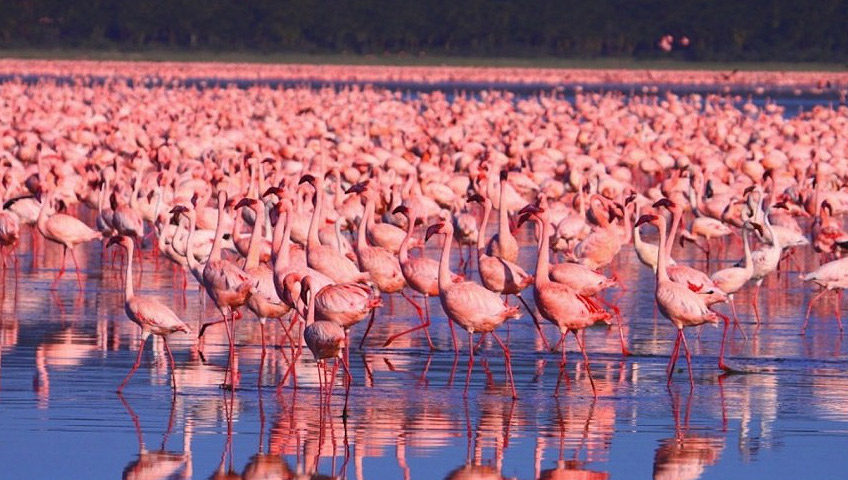
Lake Nakuru National Park
Lake Nakuru National Park (188 km²), created in 1961 around Lake Nakuru, near Nakuru Town. It is best known for its thousands, sometimes millions of flamingos nesting along the shores. The surface of the shallow lake is often hardly recognizable due to the continually shifting mass of pink. The number of flamingoes on the lake varies with water and food conditions and the best vantage point is from Baboon Cliff. Also of interest is an area of 188 km around the lake fenced off as a sanctuary to protect Rothschild giraffes, black rhinos and white rhinos.
The park has recently been enlarged partly to provide the sanctuary for the black rhino. This undertaking has necessitated a fence — to keep out poachers rather than to restrict the movement of wildlife. The park marches for 12.1 km on the south eastern boundary with the Soysambu conservancy which represents a possible future expansion of habitat for the rhinos and the only remaining wildlife corridor to Lake Naivasha.
The park now (2009) has more than 25 black rhinoceros, one of the largest concentrations in the country, plus around 70 white rhinos. There are also a number of Rothschild’s giraffe, again translocated for safety from western Kenya beginning in 1977. Waterbuck are very common and both the Kenyan species are found here. Among the predators are lion, cheetah and leopard, the latter being seen much more frequently in recent times. The park also has large sized pythons that inhabit the dense woodlands, and can often be seen crossing the roads or dangling from trees.
As well as flamingos, there are myriad other bird species that inhabit the lake and the area surrounding it, such as fish eagle, goliath heron, hamerkop, pied kingfisher and verreaux eagle.
Habitat and Wildlife
Lake Nakuru, a small (it varies from 5 to 45 square kilometers) shallow alkaline lake on the southern edge of the town of Nakuru lies about 160 kilometers north of Nairobi. It can therefore be visited in a day tour from the capital or more likely as part of a circuit taking in the Masai Mara or Lake Baringo and east to Samburu. The lake is world famous as the location of the greatest bird spectacle on earth — myriads of fuchsia pink flamingos whose numbers are legion, often more than a million — or even two million. They feed on the abundant algae, which thrives in the warm waters. Scientists reckon that the flamingo population at Nakuru consumes about 250,000 kilos of algae per hectare of surface area per year.
There are two types of flamingo species: the Lesser flamingo can be distinguished by its deep red carmine bill and pink plumage unlike the greater, which has a bill with a black tip. The Lesser flamingos are ones that are commonly pictured in documentaries mainly because they are large in number. The number of Flamingos has been decreasing recently, perhaps due to too much tourism, pollution resulting from industries waterworks nearby who dump waste into the waters or simply because of changes in water quality which makes the lake temporarily inhospitable. Usually, the lake recedes during the dry season and floods during the wet season.
In recent years, there have been wide variations between the dry and wet seasons’ water levels. It is suspected that this is caused by increasing watershed land conversion to intensive crop production and urbanization, both which reduce the capacity of soils to absorb water, recharge groundwaters and thus increase seasonal flooding. Pollution and drought destroy the flamingos’ food, Cyanobacteria, or blue-green algae, and causing them to migrate to the nearby Lakes, more recently lakes Elmenteita, Simbi Nyaima and Bogoria. Local climate changes have also been hypothesized to contribute to the changing environmental conditions in the lakes catchment. Recent media reports indicate increasing concern among stakeholders, as mass flamingo migrations and deaths could spell doom to the tourism industry.
The flamingos feed on algae, created from their droppings mixing in the warm alkaline waters, and plankton. But flamingo are not the only avian attraction, also present are two large fish eating birds, pelicans and cormorants. Despite the tepid and alkaline waters, a diminutive fish, Tilapia grahami has flourished after being introduced in the early 1960s. The lake is rich in other birdlife. There are over 400 resident species on the lake and in the surrounding park. Thousands of both little grebes and white winged black terns are frequently seen as are stilts, avocets, ducks, and in the European winter the migrant waders. Also they have a bunch of Zebra.
Access
— By Road: Distance: 156 km Northwest of Nairobi on the main A104 Road. The main gate is 4km from Nakuru Town Centre.
— By Air: Via the 12 km long ‘Naishi’ airstrip located in the southern part of the park.
Park Gates:
— Lanet gate (links the Park with the Nairobi - Nakuru highway)
— Nderit Gate
— The Main Gate
Climate
— Temperature ranges from 20-300 c and rainfall from 200mm — 700 mm
— Two rain seasons: Long rains — March & April & short rains — Nov/ December
Safaricard required
Entry is by Safari Card only. Safaricards may be loaded — but not obtained at Mtito Andei Gate. Proof of identification will be required
— Citizens — Valid Passport or National ID
— Residents — Valid Passport & re entry pass
Major attractions
— The fabulous flamingo
— An orthologist’s paradise with 450 species of birds
— Kenya’s first rhino sanctuary
— Waterfall : Malaikq
— View —points: Lion hill, baboon cliffs and Out of Africa
— Hills: Enasoit , lion hill, honeymoon e.t.c
Activity Options
— Game viewing
— Bird watching
— Camping
What to take with you
— Drinking water, picnic items and camping equipment if you intend to stay overnight. Also useful are: binoculars, camera, hat, sunscreen, sunglasses and guidebooks










